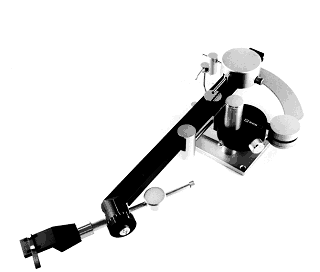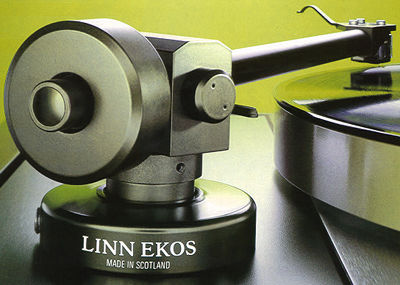Many consider the Linn Ittok to be the world’s first super-arm. It was designed by a Mr. Ito to Linn’s specifications in the late 1970s and originally built for Linn by the Denon Parts Company of Japan (no related to the electronics brand). It underwent several adjustments over the years, including a new counterbalance, until it reached its LVIII incarnation in 1989. The price had grown from its initial launch price of £230 in 1978 to over £450 by the time it was discontinued in the mid-1990s.
The Ittok is created for strength and is arguably the first arm to advocate for the maximal rigidity idea. It has a large bore alloy armtube that is bonded to a perforated magnesium headshell and a sturdy bearing assembly that houses standard ball races and a stainless tool steel central shaft. These bearings, which are very finely aligned, provide a single, rigid coupling all the way to the arm pillar’s three-point fastening. Hard rubber bushes disconnect the sliding brass counterweight from the rear end stub, and thumbwheels control the spring-applied tracking force and bias. Cabling is made of copper with exceptionally low capacitance and inductance, and is terminated by Linn phono plugs with gold plating. The Ittok is in the medium to high mass category, having an effective mass of 12g, therefore it will function with most MCs and MMs.
Linn’s own LP12 is one of Ittok’s best platforms, with which it has a lot of synergy. However, on any decent turntable, suspended subchassis or not, it’s highly effective. Most smooth sounding high end belt drives benefit from its slightly forward, energetic character. The Ittok’s bass articulation is readily noticeable after hearing a previous generation design like Grace’s G707. It’s unusually tuneful as well as extremely strong. Later super-arms, such as the Zeta, vastly improved it in the latter, but never in the former.
The midband, as you move up the frequency spectrum, becomes more detailed and open, with a nice sense of depth perspective. It photographs well – significantly better than the LP12 with which it is frequently paired – but the center is still a little hazy when compared to competing Syrinx PU3 or Zeta arms of the time. The primary power of the Ittok is its musicality. It’s still one of the most fun non-unipivot designs on the market, injecting a bouncy bounce into whatever it plays. The Ittok’s dynamics are also strong, and although being far behind the Zeta and SME V in absolute terms, it always manages to sound more expressive than its competitors.
However, the Ittok has a few flaws. Treble isn’t the most refined sounding on the market, being more forward and splashy than the best of the others, but it gets the job done. The old adage about not using bright-sounding moving coils with the Ittok (such as Audio Technicas) still holds true. The bass, while flowing, is bumpy and lacks the punch of the Zeta or SME V. Detail recovery isn’t particularly strong either, with the midband murky and the treble fuzzy. Most people don’t notice because it’s such an engaging listen, which is part of its allure.
The Ittok is inexpensive and widely available secondhand. The issue is that it isn’t the most durable cartridge carrier on the market, making it easy to get a pig in a poke. The very last LVIII is unquestionably the one to have, but it’s very tough to come across; minters can cost up to £300. A great early LVII with one owner is a better bet than a late LVIII that’s been on everyone’s LP12 – spend between £200 and £300. Spare parts are plentiful, and Linn will rebuild your Ittok for a few hundred pounds, which is a very worthwhile alternative.







